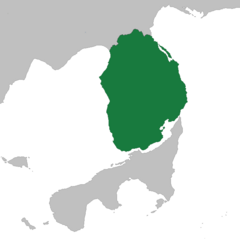Ambriya
This article is incomplete because it is pending further input from participants, or it is a work-in-progress by one author. Please comment on this article's talk page to share your input, comments and questions. Note: To contribute to this article, you may need to seek help from the author(s) of this page. |
The Supercolony of Ambriya Tze-Tza Akr-Tzy | |
|---|---|
|
Flag | |
| Motto: tbd Unison in Freedom, Freedom in Unison | |
| Anthem: tbd | |
Ambriya on the map of Sparkalia, located in west Pythia. | |
| Capital | Tri-Tzi |
| Official languages | Ambriyan, Magian |
| Ethnic groups | tbd |
| Religion | tbd |
| Demonym(s) | Ambriyan |
| Government | Eusocial commonwealth |
| Legislature | Great Hive Council |
| Area | |
• Total | 1,245,000 km2 (481,000 sq mi) |
| Population | |
• Estimate | 34,251,678
(Density: 27.5/km²) |
| GDP (PPP) | estimate |
• Total | $948,800,000,000 (Estimate) |
• Per capita | $27,000 (Estimate) |
| Currency | n/A |
| Date format | tbd |
| Driving side | n/A |
Ambriya, officially named Hive Union of Ambriya, is a country located between Gin Gulf and Eager Ocean on the Pythian continent. It is adjacent to the countries of Yessinah, Herwa and Bugwe Horde, as well as being near the Tepror Military Patrol Zone. The nation is situated in a peninsula, with a Solēbīe mountain range running in the middle of it. The landscape is characterized by steadily rising, hilly terrain, highly populated and flat coastline and many forms of flesh and fungal growths and mega organisms.
The country is inhabited by insectoid, eusocial species known as Kre-Kwa, who are organized into 32 autonomous Hives that are united under the Hive Council in an Eusocial Confederation. The country is known for containing large amounts of alien fauna and animals that were introduced by an interdimensional portal to the region during the Tēhonī invasion, as well as wide use and practice of Carnomancy. The capital settlement, which is also the largest in the nation, is the Tri-Tzi Nest.
History
Tēhonī Invasion - ~50 BR
Much of the history of the region known today as Ambriya was lost due to the effects of the Great Restart, however some information has been preserved. Around 50 years BR the region known today as Solēbīe mountains was a site of an interdimensional invasion force. The invading, demonic looking species, dubbed Tēhonī, used a wormhole as means of travel between our and their world. The goals or the purpose of the attack was forgotten, however, the theorized reason for the invasion was permanent colonization and terraformation of the territory near the portal, and possibly the entirety of Sparkalia. The portal introduced a wide variety of foreign fauna, creatures and elements that are now part of today’s country’s ecosystem. The Tēhonī also created a vast amount of species using many types of magic, with preferable use of Carnomancy.
The invasion seemingly destroyed any society that previously inhabited the region, either by accident or on purpose, with no knowledge of it being preserved by people or any ruins nor artifacts being left. The Tēhonī forces fought and tried to expand in any direction but seemingly never succeeded, whether that be because of the hostility of our environment or resistance from other nations. When the Great Restart was initiated by the Great Mage, the Tēhonī forces seemingly disappeared, with no known concrete explanation as of now how it happened. The wormhole that was the origin of the invasion was buried under the earth and closed, with the ground being raised and creating the modern day Solēbīe mountains.
Rise of the Kre-Kwa and First Hives - 1 AR to 654 AR
The aftermath of the Great Restart left the lands of Ambriya in disarray and abandonment for a very long time, as the environment has become completely alien and hostile to the outsiders trying to settle in, with many former organic machines of war still roaming around. The area was also deemed cursed by many because of the association with the demonic Tēhonī. The local fauna was relatively self contained, as the alien species had trouble expanding out from the pre-established, terraformed area..
After the vanishing of the Tēhonī, the primitive ancestors of the Kre-Kwa came into contact with the Blood Amber, and started to build hives around them, as the mana emanating from the crystals was able to give energy to the colonies. This had a side effect of accelerating growth and evolution of the species, making them increasingly larger and more intelligent, but constantly diminishing returns as the species became more advanced. By the time the effect ceased to affect the Kre-Kwa, the species advanced to be capable of creating and handling tools, as well as the ability to write.
The Kre-Kwa established the first proper settlement around 454 AR on the eastern coastline, known today as Kra-Tzi, with other nests appearing all around the Ambriyan region. The species struggled to expand forward, as the various hostile fauna and remnants of the previous Tēhonī creations attacked isolated and defenseless hives. As a result, these early Kre-Kwa societies were largely characterized by two things - a large and sometimes oversized soldier caste, and many small warning outposts scattered around one central and big hive. Within the safety of the population centers, the people were able to focus on things other than defense, increasing technological progress. Contact between other nests was limited, and conflicts between different hives were rare, as venturing outside the colony was dangerous and a waste of resources.
The eventual advancements in animal husbandry, most importantly, the ability to mount and use animals in battle, was the turning point in the Kre-Kwa history. The new found companions proved to be capable and helped to drive out former hostile creatures and Tēhonī constructs out of the Kre-Kwa territories, allowing expansion of hives into new territories.
Great Expansion - 654 AR to 899 AR
wip
Religious Awakening - 899 AR to 1021 AR
wip
Great Warring Period - 1021 AR to 1401 AR
wip
The Carnomantic Revolution - 1401 AR to 1544 AR
wip
Unification Era - 1544 AR to Present day
wip
Geography
TBD
Government
TBD

